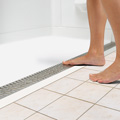
No
threshold showers were a topic of discussion at the recent IAPMO final code
hearing. Photo courtesy of Delta Faucet Co.
If you are old enough, you may remember the “good old days” when the Democratic and Republican national conventions actually selected the presidential candidate. I can remember being glued to the television, watching the vote totals and guessing what ballot it would be before a candidate emerged.
Today, both the Democrat and Republican conventions are nonevents. Everyone knows who won the primaries. The votes already are counted. There are never any surprises. The conventions are merely rah-rah events staged for television. I normally avoid them because they are scripted and boring.
With the change in theIAPMOprocedures many years ago, the final meeting to review the code changes has become equally as boring. The vote totals already are known and the testimony is staged for effect. The most recent meeting occurred in late September in San Antonio.
A caucus decides the voting the day prior to the actual code hearing. With a block vote large enough to win any code change, the group decides which changes to support or oppose. After that decision, the hearings are anticlimactic. That does not mean the hearings are void of interesting discussion. It simply means the outcome has been predetermined.
Air Admittance Valves
What would an IAPMO hearing be without a discussion on air admittance valves? There were some funny episodes regarding the testimony. The proponents of air admittance valves once again presented good technical justifications for their acceptance.The opposition initially chose not to speak against air admittance valves. Why bother? They had the votes. That is when IAPMO’s attorney prompted the opposition to speak, saying the Standards Council would need to hear justification as to why the membership voted against air admittance valves.
Often forgotten is the membership vote is not final. The action of the Technical Committee decides the final action of every code change. When the membership and Technical Committee do not agree, it goes to the Standards Council. The Standards Council also hears appeals from any code change proponent.
When considering an appeal, if there is no justification given for opposing a change, the council can only review the reasons for accepting a change. They would have to agree with the acceptance of the change.
If this was a court of law, the judge would accuse the attorney of leading the witness. The opposition did take the hint and spoke against air admittance valves. At best, the testimony was weak. The first reason given was the membership has always opposed air admittance valves. Staff pointed out there was not much technical justification in that comment. It also was argued air admittance valves do not provide the airflow rates in venting systems as required in the Uniform Plumbing Code for open venting.
The problem with the follow-up statement is there are no airflow rates in the UPC. Hence, how can there be a difference if there is no requirement?
It really didn’t matter. The membership resoundingly opposed air admittance valves and all code changes were recommended for denial.
No Threshold Showers
One of the uncomfortable code changes involved non-handicapped, handicapped showers. That is a strange title, but it applies to showers with no threshold, something always permitted for handicapped showers. Today, there are showers installed for the aging in place with no threshold. The showers are not required to be handicap-accessible and they typically do not meet all requirements of ICC A117.1.The Plumbing Technical Committee voted to allow the showers without a threshold. The membership proposed adding a requirement for an additional floor drain outside the shower. They also proposed having a water-resistant floor in the area. Many look at this requirement as being prejudicial against the elderly. The membership voted to add these requirements at the hearing.
In a recent development, the Plumbing Technical Committee voted to not approve the membership’s decision. The result is the Standards Council will have to make the final decision. One can only hope the Standards Council agrees with the Plumbing Technical Committee.
Siphonic Roof Drainage
ASPE submitted a change to recognize siphonic roof drainage. Included in the submittal was a reference to ASPE 45, the standard on the design of siphonic roof drainage systems. During the vote of the Technical Committee, the opposition stated the standard was not an ANSI standard. That is true. However, the IAPMO procedures do not require standards to be ANSI standards, only consensus standards. ASPE 45 is a consensus standard.The tune of the opposition changed to say siphonic roof drainage was an engineered design. That was one of those “duh!” moments. Some in the block of voters were under the misguided belief any design requiring engineering belongs in the appendix. Using this logic, you would have to put the entire UPC in the appendix, since engineering is involved in every commercial building plumbing system. They just do not seem to get that. The result was the rejection of the code change for siphonic roof drainage.
Recycled PVC Plastic Pipe
A surprising vote was the removal of the standard on recycled PVC plastic pipe. This was another case of the block voters not understanding the standard or the product. The opponents spoke about the failure of ABS. However, it was pointed out the failures that occurred were of ABS pipe that did not meet the ASTM standards. It had nothing to do with recycled material.Proponents pointed out how IAPMO has embraced green. They questioned how you can reject a green material standard and still consider yourself green. That did not seem to sway the block voters. The membership rejected the standard.
There were some lighthearted moments during the hearings. One testifier suggested going back to the 1964 code for one issue. That got a laugh by many and applause from others.
At the end of the hearings, some members commented they long for the “good old days” when there were real battles back and forth on the code change floor. They liked the spontaneity and feisty testimony of years past. That unfortunately seems long gone. It’s too bad because I enjoyed it as well.
The next step in the IAPMO process is a vote of the Technical Committee. When there are differences between the Technical Committee and the membership, the Standards Council makes the final decision the first week of November. Results will be published shortly after the council meeting. The 2011 edition of the UPC should be published in the early part of 2012.



